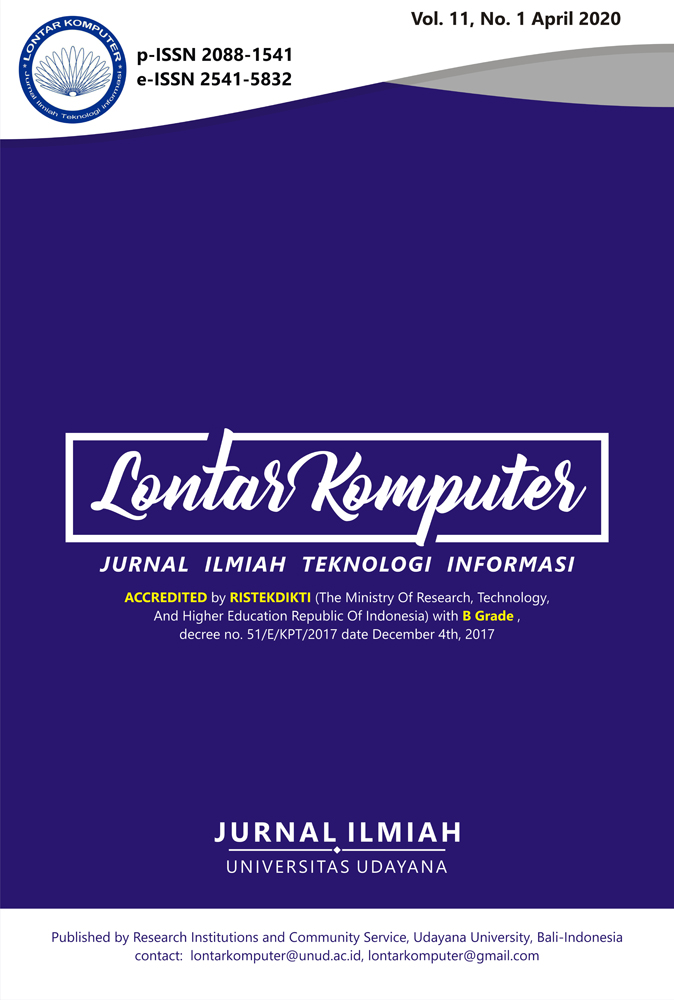Customer Segmentation Based on RFM Model Using K-Means, K-Medoids, and DBSCAN Methods
Abstract
A problem that appears in marketing activities is how to identify potential customers. Marketing activities could identify their best customer through customer segmentation by applying the concept of Data Mining and Customer Relationship Management (CRM). This paper presents the Data Mining process by combining the RFM model with K-Means, K-Medoids, and DBSCAN algorithms. This paper analyzes 334,641 transaction data and converts them to 1661 Recency, Frequency, and Monetary (RFM) data lines to identify potential customers. The K-Means, K-Medoids, and DBSCAN algorithms are very sensitive for initializing the cluster center because it is done randomly. Clustering is done by using two to six clusters. The trial process in the K-Means and K-Medoids Method is done using random centroid values ??and at DBSCAN is done using random Epsilon and Min Points, so that a cluster group is obtained that produces potential customers. Cluster validation completes using the Davies-Bouldin Index and Silhouette Index methods. The result showed that K-Means had the best level of validity than K-Medoids and DBSCAN, where the Davies-Bouldin Index yield was 0,33009058, and the Silhouette Index yield was 0,912671056. The best number of clusters produced using the Davies Bouldin Index and Silhouette Index are 2 clusters, where each K-Means, K-Medoids, and DBSCAN algorithms provide the Dormant and Golden customer classes.
Downloads
References
[2] I. K. Gede, D. Putra, and D. S. H, "Combination of Adaptive Resonance Theory 2 and RFM Model for Customer Segmentation In Retail Company," International Journal of Computer Applications, vol. 48, no. 2, pp. 18–23, 2012.
[3] K. M. Manero, R. Rimiru, and C. Otieno, "Customer Behaviour Segmentation among Mobile Service Providers in Kenya using K-Means Algorithm," International Journal of Computer Science, vol. 15, no. 5, pp. 67–76, 2018.
[4] R. A. Carrasco, M. F. Blasco, J. García-Madariaga, and E. Herrera-Viedma, "A Fuzzy Linguistic RFM Model Applied to Campaign Management," International Journal of Interactive Multimedia and Artificial Intelligence, vol. 5, no. 4, p. 21-27, 2019.
[5] S. A. Mustaniroh, U. Effendi, and R. L. R. Silalahi, "Integration K-Means Clustering Method and Elbow Method For Identification of The Best Customer Profile Cluster Integration K-Means Clustering Method and Elbow Method For Identification of The Best Customer Profile Cluster," IOP Conference Series: Materials Science and Engineering, vol. 336, pp. 1-6, 2017.
[6] Z. Rustam and A. S. Talita, "Fuzzy Kernel K-Medoids Algorithm for Multiclass Multidimensional Data Classification," Journal of Theoretical and Applied Information Technology, vol. 80, no. 1, pp. 147–151, 2015.
[7] N. Made, A. Santika, I. K. Gede, D. Putra, and I. M. Sukarsa, “Implementasi Metode Clustering DBSCAN pada Proses Pengambilan Keputusan,” Lontar Komputer, vol. 6, no. 3, pp. 185–191, 2015.
[8] D. Virmani, S. Taneja, and G. Malhotra, "Normalization Based K-Means Clustering Algorithm," Journal of Advanced Engineering Research and Science, vol. 5, no. 6, pp. 1–5, 2015.
[9] M. Madhiarasan and S. N. Deepa, "A Novel Criterion to Select Hidden Neuron Numbers in Improved Back Propagation Networks for Wind Speed Forecasting," Application Intelligence, vol. 44, no. 4, pp. 878–893, 2016.
[10] P. Pengelompokan, R. Kost, D. I. Kelurahan, and T. Semarang, “Perbandingan Metode K-Means dan Metode DBSCAN pada Pengelompokan Rumah Kost Mahasiswa di Kelurahan Tembalang Semarang,” Jurnal Gaussian, vol. 5, pp. 757–762, 2016.
[11] I. Kamila et al., “Perbandingan Algoritma K-Means dan K-Medoids untuk Pengelompokan Data Transaksi Bongkar Muat di Provinsi Riau,” Jurnal Ilmiah Rekayasa dan Manajemen Sistem Informasi, vol. 5, no. 1, pp. 119–125, 2019.
[12] I. V Anikin, "Privacy Preserving DBSCAN Clustering Algorithm for Vertically Partitioned Data in Distributed Systems," International Siberian Conference on Control and Communications, vol. 10, pp.1-4, 2017.
[13] K. Hamdi and A. Zamiri, "Identifying and Segmenting Customers of Pasargad Insurance Company Through RFM Model (RFM)," International Business Management, vol. 10, no. 18. pp. 4209–4214, 2016.
[14] Y. Nugraheni, "Data Mining Using Fuzzy Method for Customer Relationship Management In Retail Industry," Lontar Komputer, vol. 4, no. 1, pp. 188–200, 2013.
[15] B. Jumadi Dehotman Sitompul, O. Salim Sitompul, and P. Sihombing, "Enhancement Clustering Evaluation Result of Davies-Bouldin Index with Determining Initial Centroid of K-Means Algorithm," International Conference on Computing and Applied Informatics, vol. 1235, no. 1, pp. 1-6, 2019.
[16] A.-M. Shoolihah, M. T. Furqon, and A. W. Widodo, “Implementasi Metode Improved K-Means untuk Mengelompokkan Titik Panas Bumi,” Jurnal Pengembangan Teknolologi Informasi dan Ilmu Komputer Universitas Brawijaya, vol. 1, no. 11, pp. 1270–1276, 2017.
The Authors submitting a manuscript do so on the understanding that if accepted for publication, the copyright of the article shall be assigned to Jurnal Lontar Komputer as the publisher of the journal. Copyright encompasses exclusive rights to reproduce and deliver the article in all forms and media, as well as translations. The reproduction of any part of this journal (printed or online) will be allowed only with written permission from Jurnal Lontar Komputer. The Editorial Board of Jurnal Lontar Komputer makes every effort to ensure that no wrong or misleading data, opinions, or statements be published in the journal.
 This work is licensed under a Creative Commons Attribution 4.0 International License.
This work is licensed under a Creative Commons Attribution 4.0 International License.























